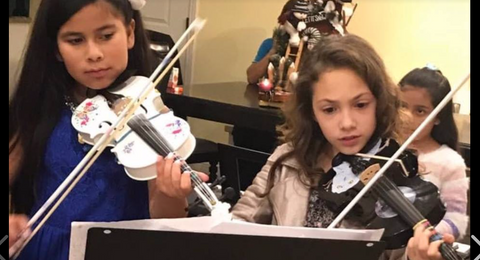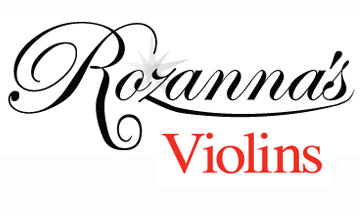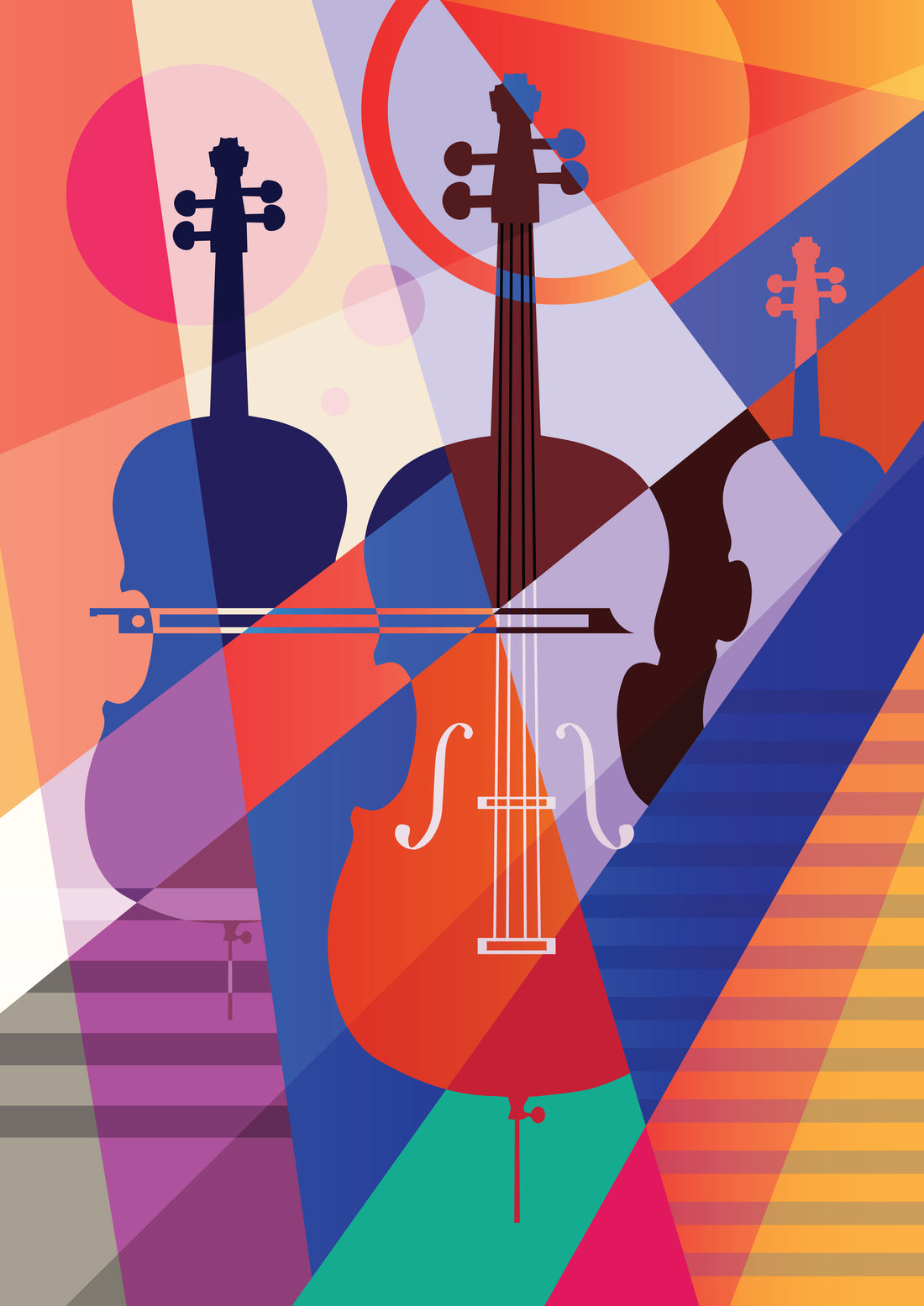Realities of the Changing World of String Playing
The question of quality when it comes to color violins is one we hear quite often. Color violin offerings have been around for many years. And the truth is that many of these color violins that originally populated the market were cheaply made and intended for an uninformed consumer. But much has changed over the past several years. Many musical styles not usually associated with the violin have now come into vogue. Pop, Rock, Jazz, Country, and just about any musical style one can imagine can include a violin. As such many players are seeking instruments that reflect modern sensibilities. Not only have ensembles become more modernized to keep up with the times and appeal to modern audiences, but many teachers are also beginning to understand that if an instrument resonates with a player's personality and style it can provide greater incentive for a student to learn. And it is perhaps at least in part because of Darwinism that the collective whole has a way of dictating what direction industry trends will follow as well as the look and sound of string playing now and in the future. Keep up with the changing times or struggle to survive.
One reason color instruments generally get a bad rap is that they are not usually seen as something that a 'serious' player would use. This was especially believed to be true 10-20 years ago when the career options for a bowed string instrumentalist included orchestra, chamber music, and other types of playing opportunities associated with classical music. Classical music is a wonderful genre rooted in traditions from the past but possesses timeless value. Playing in an orchestra, for example, requires a kind of cohesion that necessitates that no particular player stands out unnecessarily. This is also one reason color instruments may be frowned upon by teachers. It may be wise to check with the teacher to determine if it will be ok to bring a color instrument to an ensemble environment.
Teachers and parents have tried to control the conversation but in the end, so much has to do with what will inspire a child to play the violin and how to make it relatable. While there was a time when it was considered inappropriate for a serious string player to consider playing on a violin with color and/or design elements on the surface of the instruments, the look and sound of string playing in the 21st century requires instruments that reflecting these changing musical trends. This posting will address some of the questions, truths, and falsehoods that may be associated with these instruments so that the interested shopper can proceed in choosing an instrument with greater confidence.

Students of Sandra Ortiz perform in concert together.
Are color violins made cheaply?
The short answer is yes and no. Not all violins are made equally. Most color violins that originally came into the USA and sold online, were generally better classified as toys. The violins were usually made quite cheaply, from inexpensive wood more suitable for general construction than for a wooden instrument intended to sound and look good. Rather than solid maple, for example, they may have been constructed with plywood. There is still an assortment of such instruments available especially online. The truth is that while many customers naturally want the best deal possible unless one is savvy about what to look for in terms of how the instrument looks and the product description it's possible to be very disappointed. The old adage 'you get what you pay for' may not be more true than when it comes to color violins but that does not mean it's not possible to find a good deal on a quality violin that is made well and sounds good.
Many parents want their children to take an interest in playing music but may also have budgetary constraints. As such they might typically order a color instrument that is made from poor quality materials as well as being factory-made, meaning the instruments will largely be machine manufactured vs. hands-on craftsmanship by a discerning luthier. And while most reasonably priced violins are factory made, including the decent student violins that fill the market, its important to recognize the level of detail required by a hands-on professional luthier to ensure there is sufficient craftsmanship involved in the production of the instrument. Generally, teachers may recognize what to look for but some teachers may outright reject an instrument because it is not traditional looking. And of course, if an instrument has diminishing returns in terms of playability and sound quality, over time the student may become discouraged to play.
But the good news is that there are more and more reputable manufacturers producing instruments that both reflect the demand for a quality instrument that a student can enjoy while having a visual impact that the player can also appreciate.
How do color violins compare to traditional violins?
The truth is that the qualities and product attributes found in a quality traditional-looking violin are the same as what one would want in a color violin. The attributes to pay attention to include:
- Material applied to the surface
- Quality & type of wood used
- The material used for fittings including fingerboard, pegs, tailpiece & chin rest
- Quality of tonewood
- Level of craftsmanship and amount of care to detail
Material Used to Color a Violin
Most people assume that if a violin has color beyond the traditional it is 'painted'. This is an oversimplification of the ways these instruments can be produced. Some instruments use a type of color application and it may be painted or it could be stained much like a traditional violin can be stained. But there are other factors to consider. How thick is the material used and how does it compare in thickness to the many layers of stain & other types of finishing products when producing a traditional violin. And finally, is the material used on an instrument conducive to optimal sound vibration of the instrument or is the sound production dampened by the material used to color an instrument. Much like high-quality pianos, guitars may have be available in a choice of colors, so too do violins now have this option.
Wood
In general, most decent student and mid-level violins are made with solid spruce top, maple back & sides. Some instruments use basswood but this is not generally acceptable quality for the violin. Maple and spruce are considered a good choice for tonewood. Wood quality takes into account factors that would not ordinarily be considered for general construction wood because violins are being used to produce sound. As such the selection of wood for violins factors in the quality tonewood being used.
There is also the issue of flaming, which is a factor in standard violins as such it is coveted because of the aesthetics. While there are certain theories about the impact of flaming on sound quality, it is not always a factor. Further, because color violins are typically opaque, the flaming of the wood will not be important unless the color application is a stain. This leaves open the possibility of constructing a color violin using wood that wouldn't normally be aesthetically pleasing for a traditional violin but will be fine for a color violin. And this can spell savings for the manufacturer as well as the end-user. Thus the customer can save on the cost of a color violin that is made with quality sounding tonewood.
The cost of the wood will, of course, be passed on to the consumer but unless the consumer is savvy in this area, one may find it difficult to assess the quality of an instrument. This may seem to be compounded when buying online but if the customer looks carefully at the attributes of the construction, bad buying decisions can be avoided. Still, online purchases are a great option because the cost of buying online will generally work to the advantage of the customer.
If it's not possible to try out the instrument in advance there are a few indicators that will help inform the customer. 1. Check for any online videos of players using the brand in question. 2. Consider the price of the instrument. The adage 'you get what you pay for' may never be so true as when purchasing a violin. If the price is super cheap it stands to reason the quality of the tonewood will not be too great. 3. If the brand has a following along with endorsements by respected teachers or parents, it may be a decent instrument to play.
Fittings
Ebony is generally the wood of choice for fittings. Unless the description says the fittings are made with ebony, there are many other types of wood that could be used and simply painted black. Some instruments may use an ebony fingerboard and pegs but use a plastic tailpiece and chin rest. Descriptors such as ebonite, blackened wood, aluminum allow are all lesser materials that may be used rather than genuine ebony. Hardwood or pearwood may also be used. These are considered inferior. Pearwood, for example, is a softer wood thus it may incur wear & tear more quickly.
Craftsmanship
There are telltale signs that an instrument is made poorly. The trained eye can spot them more readily but an educated shopper can also learn what to look for in craftsmanship.
- Inlaid purfling is generally seen on good quality instruments. Lesser violins may have 'painted purfling' that is only superficially applied to the top of the violin.
-
Poorly made color violins may also be difficult to tune because the pegs are not sufficiently carved to fit into the pegbox. Telltale signs that this is the case will be when the part of the peg that goes into the pegbox cannot fit all the way into the pegbox, leaving a white area where the peg cannot go further into the pegbox. Or it may stick out beyond the pegbox because it slips into the pegbox too easily.
- The cut of the bridge is also important. For example, a poor quality violin will have a bridge that has minimal work done to it. This may include insufficient curvature at the top of the bridge, making it difficult for the player to clear the different strings effectively. There may be no notches for the string or notches that are barely cut, making it difficult for the string to sit in groove. The height is also important because if the bridge is not the correct height, strings may sit too high above the fingerboard. The general test is whether a credit card can go between strings and fingerboard. If the distance is greater than this it is likely the bridge height is too high.

- Notice in the sample above how flat the top is, making it difficult to clear each string. The grooves are also nearly imperceptible and will make it difficult for the strings to remain in place.
- Notice in the sample below how distinct the curve is on the bridge. There is a sharper curve on the right side for the E string and this is important for playing purposes. And note the distinct grooves so strings can easily stay in place.

The neck is another indicator of the level of craftsmanship. As previously mentioned the type of wood typically used for a decent quality violin is maple. Most violin makers will leave the natural wood uncovered with a color other than a protective finish of some sort. But color violins that are made poorly will often have necks that are painted the same color as the rest of the instrument. This is indicative of a lack of attention to detail when the instrument was being made.

Notice with the pink violin above how the neck and entire violin are all pink color. This is a sign of a lesser quality violin.
The violin below is color however the neck is left natural wood. The plain wood vs color area is also clearly defined. In many cheaply made violins even when the natural wood is allowed to show through there may be a sloppiness in the edging of the color to the natural wood area.

While this article has primarily focused on quality factors specific to color violins. there are certainly many similarities in terms of what the consumer should look for in a natural wood violin. The world of violin playing will continue to expand beyond the confines of previous generations and the tools needed to meet those possibilities will continue to evolve. Fortunately, the natural tendency of any market is that there will eventually be many great options for players and hopefully the knowledge needed to make informed decisions will give confidence to aspiring musicians.




1 comment
I will be getting a settlement sometime after the first of the year. I play the violin and may be interested in one of the color violins can you send me more info via email?
Thanks!
Kathy Kayser